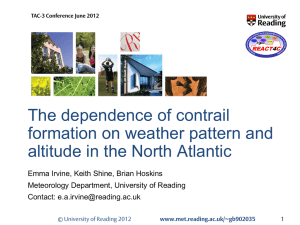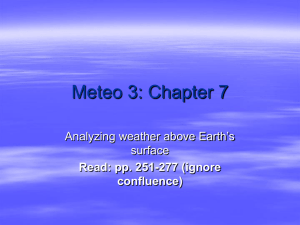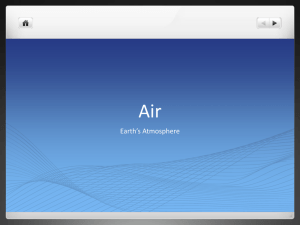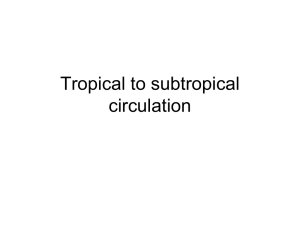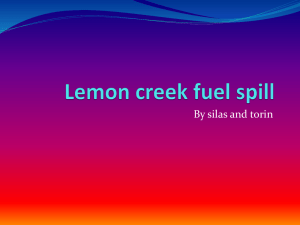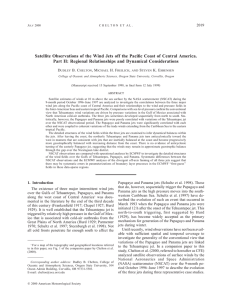Low-level Jets in the Tropical Americas
advertisement
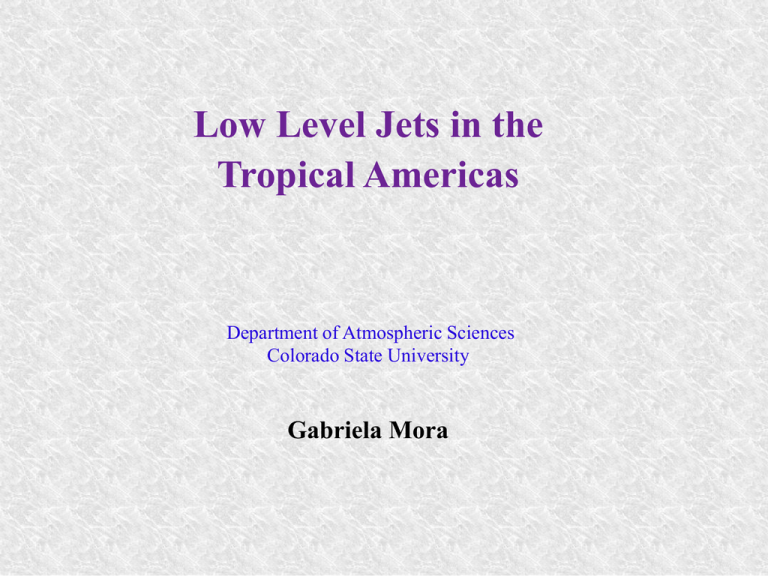
Low Level Jets in the Tropical Americas Department of Atmospheric Sciences Colorado State University Gabriela Mora Motivation and Introduction Understand the dynamics of the low level jets in the tropical Americas Study the convection, vorticity, divergence and sea surface temperature associated with these jets Climatology of the wind influences the weather and its prediction Main weather fields are strongly correlated with each other Jets play an important role inhibiting or enhancing convection Background Relevant features 1) Cold tongue: located on the west coast of Ecuador and Peru explained by wind-driven Ekman transport (July-November) 2) Double ITCZ: - two simultaneous ITCZ's - caused when the cold tongue is present and inhibits convection at the equator and splitting the ITCZ in two 3) Gaps in the topography: - Isthmus of Tehuantepec - Papagayo Gap - Isthmus of Panama Background Relevant features 4) Jets: - Caribbean Low Level Jet (CLLJ): JJA, DJF - Tehuantepec: ONDJF, JA - Papagayo: DJFMA, JA - Panama: DJFMA - Choco: SON 5) Western Hemisphere Warm Pool (WHWP): - SST's > 28.5°C - Divided into four regions: Eastern North Pacific Gulf of Mexico Western Tropical North Atlantic Caribbean 6) Costa Rica Dome: - Dome in the thermocline - 20°C isotherm lies 30 m below the sea surface Data Wind QUIKSCAT 2000-2007 -- spatial resolution: 0.25°, temporal resolution: twice daily NCEP Re-analysis 1948-2006 -- spatial resolution: 2.5°, temporal resolution: monthly Precipitation Tropical Rainfall Measuring Mission (TRMM) 2000-2007 -- spatial resolution: 0.25°, temporal resolution: monthly Sea Surface Temperature NCEP/NOAA Optimum Interpolation (OI) Analysis 2000-2007 -- spatial resolution: 1°, temporal resolution: monthly ENSO Index ENSO Years – NOAA 1998-2005 Main features: Cold Tongue July September August October Main features: Western Hemisphere Warm Pool March May April June Main features: Western Hemisphere Warm Pool July September August October Main features: Low-Level Jets January July September Main features: Caribbean Low Level Jet Primary maximum December January February Secondary maximum June July August Main features: Tehuantepec Jet Primary maximum October January November February December Main features: Tehuantepec Jet Secondary maximum July August Main features: Papagayo Jet Primary maximum December January February Secondary maximum July August Main features: Panama Jet January February March Main features: Choco Jet September October November Main features: Double ITCZ February Divergence March April Main features: Double ITCZ March February Precipitation April Main features: Double ITCZ Precipitation (from TRMM) April during La Nina event 2001 April during El Nino event 1998 Main features: Costa Rica Dome Dome in the thermocline explained by wind forcing 20°C isotherm lies 30 m below the sea surface Produces a “dry hole” in the ITCZ, which can reach 500 km in diameter Strong Papagayo jet Cyclonic wind stress curl January Vorticity Anticyclonic Cyclonic Dome: annual cycle Feb-Apr: coastal shoaling of the thermocline May-Jun: separation from the coast Jul-Nov: thermocline ridge shoals, dome expands to the west Dec-Jan: deepening Cloud frequency May-Nov, 2006 CIRA/RAMM Main features: Costa Rica Dome Sverdrup relation: f2 h h = w dx E e g' H β h: thermocline depth anomaly H: mean thermocline depth E: eastern boundary g': reduced gravity we: Ekman pumping velocity df β dy Conclusions The Caribbean Low Level Jet, Tehuantepec Jet, Papagayo Jet and Panama Jet, respond mostly to pressure gradients between the Atlantic and Pacific Ocean, accelerating the winds toward the Pacific. These pressure gradients have been explained by: 1) cold fronts from the North Hemisphere, push high pressure systems from midlatitudes to the tropics. 2) the annual cycle of the North Atlantic Subtropical High, which is more intense during the boreal summer. The Choco Jet owes its existence to the meridional temperature gradient between the Cold Tongue and western Colombia. The Papagayo Jet has cyclonic vorticity on the left side of its exit, which generates Ekman pumping and upwelling in the ocean, producing a dome in the thermocline (the Costa Rica dome). Conclusions Double ITCZ is found from February to April during neutral and La Nina ENSO conditions Future work Use of pilot balloons to study the wind vertical profile in the continental Papagayo region Study the correlation of cold fronts and the CLLJ Study the correlation of the North Atlantic Subtropical High with the CLLJ Compare the wind results obtained with the NCEP data, with another database Extra slides Cold tongue Western Hemisphere Warm Pool Region I Gaps in the topography Main features: Caribbean Low Level Jet Vertical profile: zonal wind, meridional wind, wind speed Main features: Tehuantepec Jet Vertical profile: zonal wind, meridional wind, wind speed Main features: Papagayo Jet Vertical profile: zonal wind, meridional wind, wind speed Main features: Panama Jet Vertical profile: zonal wind, meridional wind, wind speed Main features: Choco Jet Vertical profile: zonal wind, meridional wind, wind speed Double ITCZ Main features: Double ITCZ January April February May March June July October August November September December Costa Rica Dome 20˚C isotherm depth (m) Data from World Ocean Database 1998 (Conkright et al., 1999) Conkright, M.E., Levitus, S., O’Brien, T., Boyer, T.P., Stephens, C., Johnson, D., Baranova, O., Antonov, J., Gelfeld, R., Rochester, J., Forgy, C., 1999. World ocean database 1998 CD-ROM data set documentation, Version 2.0. NODC Internal Report 14, 116pp.





